Yves here. Many commentators have taken note of Putin exhorting the Russian public not to what in the past was called foreign agitators to use the Crocus City Hall massacre to foment ethnic schisms in Russia. The attack was perpetrated by Tajik mercenaries for what seems like a pittance, reflecting poverty and income levels back at home. There was already resentment of immigrants from the ‘Stans due to the perception (not incorrect) that they were undercutting pay levels of native Russians.
However, many ethnic groups in Russia are natives, such as most of its Muslim population. Putin also regularly talks up the success of Russia as a multi-ethnic society to foster pride in that diversity.
One indicator: a friend who has a prodigious knowledge of and interest in shopping and collecting, high end and low, recalled a visit to A La Vieille Russie, a New York City institution of sorts. From Wikipedia:
A La Vieille Russie is a New York City-based antique store specializing in European and American antique jewelry, Imperial Russian works of art, 18th-century European gold snuff boxes, and objets d’art.
At the time, A La Vieille Russie was displaying a collection of 100 dessert plates that Catherine the Great commissioned for her use. My friend described how and why china back in that day was extremely expensive and therefore prized.
But why 100 plates? Each had a differing painting in the center, to commemorate every one of the 100 ethnicities under her rule.
By John Helmer, the longest continuously serving foreign correspondent in Russia, and the only western journalist to direct his own bureau independent of single national or commercial ties. Helmer has also been a professor of political science, and an advisor to government heads in Greece, the United States, and Asia. He is the first and only member of a US presidential administration (Jimmy Carter) to establish himself in Russia. Originally published at Dances with Bears
“The unity of Russia’s multiethnic society,” President Vladimir Putin told the Russian Trade Union Congress on Thursday, “is the main fundamental condition of our success. In this connection, and based on the initial results of the investigation, we have grounds to believe that the main goal of those who masterminded the bloody and heinous terrorist attack in Moscow was to damage our unity.”
Putin is repeating the message – four times in two weeks: earlier on March 23, March 25, and April 2 — because it happens to be true.
What also happens to be true is that during the Yeltsin period, when asked by Moscow university students what I thought of anti-semitism in Russia, I said: Russians are the most primitive white tribe in the world – they are hostile to the other tribes, the Jews, Chechens, Armenians, Chukchi, Uzbeks, Tajiks — each one of them equally. After this sociology was elaborated, invitations to lecture at Moscow universities stopped.
The sociological problem which Russia’s enemies have is that the foreign white tribes, like the Galicians of the Ukraine, the Anglo Saxons, and the Blin-Noodle gang ruling Washington, make the primitive sociological mistake of thinking they can trigger intercommunal warfare inside Russia, to weaken and break it up. The British Secret Service (MI6) made their first abortive attempts at this during the Bolshevik revolution and the civil war following. The US Central Intelligence Agency (CIA) and MI6 have been plotting the same thing since 1945, increasing the resources and accelerating their efforts in the Caucasus during the Yeltsin administration of the 1990s.
It is therefore no surprise they have convinced their Ukrainian counterparts to implement the same scheme. On Tuesday of this week, The Times of London headlined this plan “Ukraine Stokes Anti-Immigrant Tensions in Russia”. The newspaper – in the 19th century nicknamed “The Thunderer”, now owned by Rupert Murdoch, nicknamed “The Dirty Digger” — reported an interview with Andrei Kovalenko, head of the Ukraine’s Centre for Countering Disinformation (CCD). By weaponizing local ethnic communities like the Tajiks in Russia, the operational objective, according to Kovalenko, is “to exploit divisions and distrust among the Russian public.”
Kovalenko is conceding the Ukraine strategy behind the Tajik gunmen’s attack on the Crocus City Hall on March 22. But the foreign tribesmen have misread the Russian sociology again. The attack has failed in its war objective.
Follow the story and the evidence of the Crocus City Hall events here.
The theory of interethnic conflict in Russia was last tested in Moscow in January 2022 by the Levada Centre, a pollster registered as a foreign agent in 2016. Levada has been surveying ethnic Russian attitudes towards other ethnic groups since 2011, emphasizing for its own reasons what the Levada staff call anti-Semitism. The polling results over the years show that positive and negative Russian sentiment has been moving on several measures of social distance — acceptance as family members, friends, neighbours, citizens, temporary workers on visa – in different directions for different ethnic groups.
The improvement in the Russian perception of Ukrainians and Jews has been sharply reversed by the Kiev war on the Donbass and then the Israeli war against Gaza. By contrast, the political, economic, and media efforts of the Putin administration to cultivate strategic relations with China, the African states, and the Caucasus, including Chechnya, have accentuated the positive, diminished the negative.
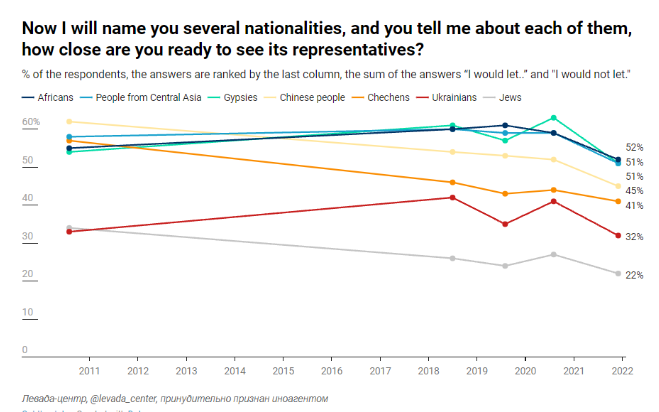
Source: https://www.levada.ru/
Lev Gudkov, Levada’s chief sociologist (Jewish), reporting on the December 2021 survey, has been reluctant to admit that Soviet ideology and Marxist education significantly reduced Russian xenophobia and racism, and that the impact of the Yeltsin revolution – which Gudkov supported personally – reversed this. “Xenophobic sentiments, weakly expressed at the time of the collapse of the USSR, gradually increased by the end of the 1990s,” Gudkov reported in January 2022. Gudkov has also not acknowledged that since 2013 rising real incomes, employment mobility, and public optimism have acted together to reduce the negative sentiments of the 1990s. “The Crimean euphoria noticeably reduced their level and intensity of expression, channeling latent hostility of this kind and concentrating negativity on the images of the ‘Russophobic West’ and ‘Ukrainians’, ‘Bandera’.”
“The overall intensity of negative attitudes has been decreasing in recent years. This is especially noticeable in relation to ‘Jews’ (an increase in positive attitudes from 2010 to 2021 from 22% to 45%; a decrease in negativity and various kinds of restrictions over the same period from 34% to 22%), ‘Chinese’ (the share of positive or neutral responses increased from 12% to 28%; the share of negative decreased from 62% to 45%), ‘Chechens’ (the share of indicators of tolerant attitudes increased from 9% to 22%, negative decreased from 57% to 41%). The attitude towards Africans retains a predominantly negative and cautious tone (an increase in tolerant opinions from 12% to 22%, negative ones remained almost the same, 58%-60%, during 2010-2020, dropping by December 2021 to 51%). The same can be said about Gypsies (the growth of positive attitudes from 7% to 15%; the volume of negative attitudes ranges from 54% to 63% in August 2020, then decreases to 51%).”
Also, Gudkov’s survey of December 2021 confirmed that in the Russian labour market, the migrant worker problem has been intensifying, although unreported Levada data show that the balance between positive and negative sentiment varied markedly between regions and cities, and between income and age groups; that is to say, there is a correlation by social class.
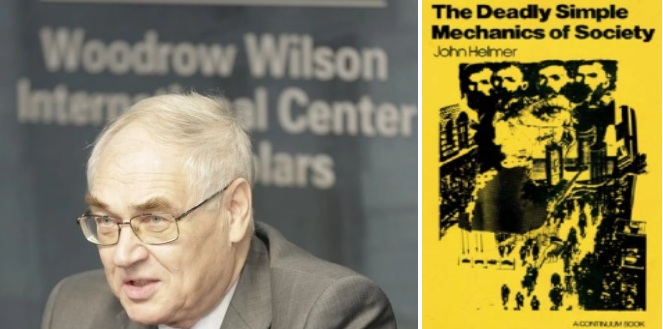
Left: Lev Gudkov at the state think tank in Washington; right, John Helmer on class in US sociology. Class in the Soviet or Marxist meaning is not measured or reported by Gudkov and the Levada sociologists. They follow the US academic doctrine; they reject that “reality is Marxist”, as Michael Parenti once said. For more on reality in American sociology, read this.
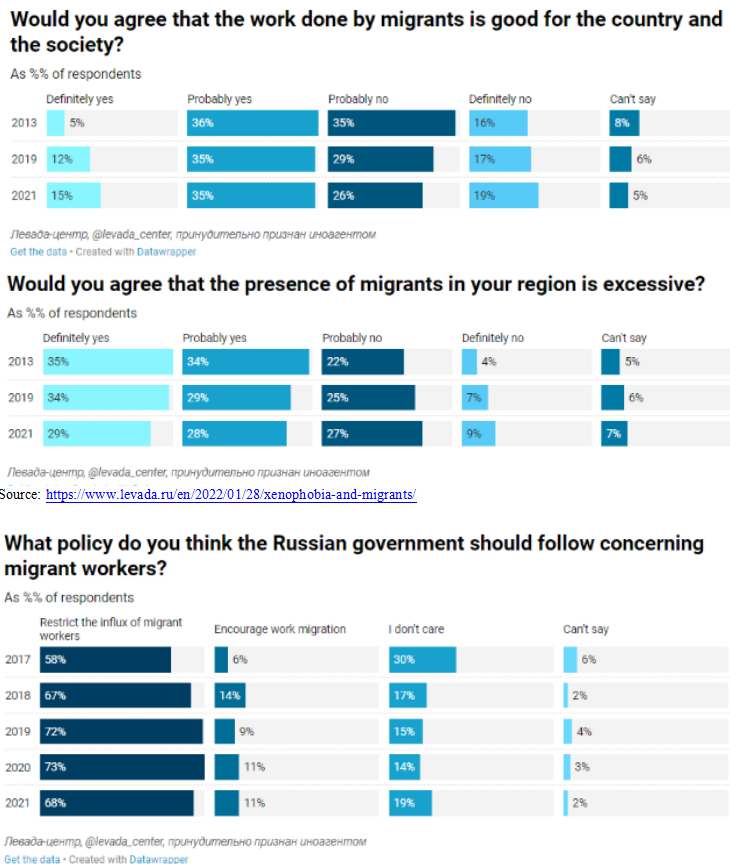
Source: https://www.levada.ru/
Gudkov: “The most obvious expression of non-reflexive antipathy [sic] and anxiety is the attitude towards migrant workers. It has the character of frank wishes that the authorities limit the flow of migrants, introduce various prohibitive barriers and measures for migrants. Over the past 5 years, the share of those who believe that the government should prevent the flow of migrants has grown from 58 to 68-73%. This is the dominant public opinion.”
In his public assessments of the Crocus City Hall attack, President Putin has been carefully balancing the elements of public support for combating Russia’s foreign enemies and for remedying domestic labour market stress. In parallel, since March 22 there has been a new drive by police and prosecutors to crack down on illegal immigration from Central Asia and on the state official corruption which has encouraged it.
There is no Marxism in the mainstream Moscow media, but there is reality.
Yesterday, Yevgeny Krutikov published this analysis of the Ukrainian plan for the Crocus City Hall attack by Tajik gunmen to incite intercommunal, racial violence in Russia’s cities. The essay appears in the semi-official platform for political and geostrategic analysis, Vzglyad. Omitted from the analysis is whether, if the four gunmen had evaded capture by Russian forces and crossed the Ukrainian border, they would have been more value in the Ukrainian scheme dead than alive.
The translation into English is verbatim without editing. Captioned illustrations have been added.
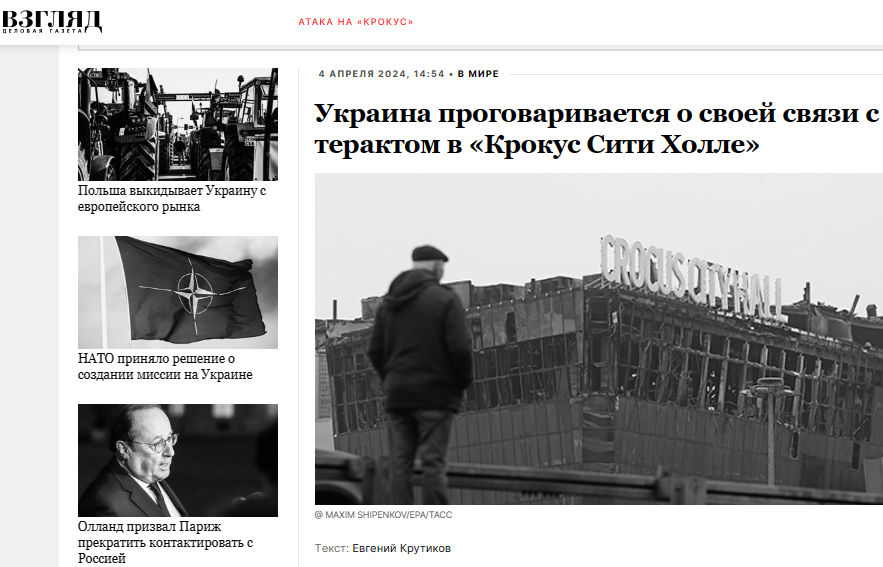
Source: https://vz.ru/world/2024/4/4/1261542.html
 April 4, 2024
April 4, 2024
Ukraine talks about its connection with the terrorist attack in Crocus City Hall
By Yevgeny Krutikov
The leadership of the Ukrainian special services openly admits that it “inflames ethnic tensions” in Russia “with the help of information.” In what ways and tools does the Kiev regime sow ethnic strife in our country and how are things really going with interethnic tensions?
Ukrainian agents are conducting a campaign of psychological operations (psyops), which is aimed at destabilizing Russia after the terrorist attack at Crocus City Hall by inciting ethnic conflicts. This was told to the British newspaper, The Times, by Andrei Kovalenko, the head of the Centre for Countering Disinformation (CPD) at the National Security and Defense Council (NSDC) of the Ukraine.

Source: https://www.thetimes.co.uk
According to Kovalenko, for Ukraine, provoking tension between ethnic groups within Russia is “fertile ground.” Since the terrorist attack at Crocus City Hall in Moscow, Ukrainian agents have become more active in Telegram channels and are trying to incite ethnic strife using the ethnic origin of the terrorists. Among the detainees, the four direct perpetrators are citizens of Tajikistan.
“Of course, it is very beneficial for us to support any national splits there [in Russia] and to warm them up with the help of information…We are using everything we can because we know that by stoking ethnic tensions, we are weakening Russia,” Kovalenko said.
The Times notes that the CPD of Ukraine is trying through Tajik Telegram channels to evoke sympathy for the terrorists, who were roughed up when they were detained by Russian security forces. Thus, Ukrainian agents are provoking Tajik citizens against the Russian law enforcement agencies.
In parallel, there have been other attempts to turn Russians against migrants or provoke conflicts between other ethnic or religious groups. The head of the Centre at the National Security Council also said that Kiev has fueled various rumours to pit Russians and Chechens against each other.
First of all, it is surprising that the heads of the Ukrainian special services — if we consider the Centre for Countering Disinformation (CPD) and the Centre for Information and Psychological Operations (CIPsO) as special services — regularly engage in such self-disclosure sessions. Not so long ago, the head of the Ukrainian Security Service (SBU), Vitaly Malyuk, confessed to organizing terrorist attacks on the territory of Russia, and the Russian Foreign Ministry demanded that Kiev extradite him. Maybe the Ukrainians are simply obliged to publicly report to the Western audience about the work they have done?
It is also significant that Ukraine openly approves of the very idea of the terrorist attack on Crocus City Hall. “The main goal of terrorists and their customers is to sow discord and panic, strife and hatred in our country, to split Russia from within,” Russian President Vladimir Putin has said after the event. The fact that the leadership of the Ukrainian special services confirms this goal, in fact, proves once again the connection of the Kiev regime with the organizers and perpetrators of this crime.
But the main thing is that Kovalenko is “selling” the West a myth, to put it mildly. There is no “national split after the terrorist attack” in Russia, although the enemy is making significant efforts to incite discord. There is no “wave of xenophobia” either.
Ukrainians and Russian liberal exiles broadcast to Western politicians, experts, and the media a distorted view of Russia and its internal processes. It’s wishful thinking.
In particular, as recently as a few months ago, the head of the [Russian] Federal Agency for Ethnic Affairs, Igor Barinov, said that since the beginning of the Special Operation in Russia, not a single significant conflict on ethnic and interreligious grounds has been recorded. “Our opponents in the West have chosen interreligious relations as a target, they believe that this is a weak point of our country, and through this they are trying to upset the internal political situation, weaken public support for the Special Military Operation. And despite this, we see that the state national policy has withstood the challenge,” Barinov said.
The terrorist attack at Crocus City Hall is undoubtedly a monstrous event, but in terms of the magnitude of what is happening, it is smaller in scale than the Ukrainian special operation which has been going on for more than two years. This means that its impact on Russian society will be less.
In this sense, the statements of the Ukrainian special services play into Russia’s hands. The incorrect information that the West receives from the Kiev regime leads to incorrect assessments and to the development of wrong decisions based on them. It is enough to watch some debates about Russia at the well-known British analytical centre Chatham House with the involvement of local academic experts, to see how far from reality their idea of life in Russia and the sentiments of Russian citizens is. Let them keep making mistakes.
Russia is unique not only for its ethnic diversity, but also for the very form of coexistence of different peoples and religious groups. In Russia, during its entire historical path, there was almost no forced assimilation of small peoples. Moreover, minority cultures, languages, and identities were maintained at the state level, especially during the Soviet period.
On the one hand, this was a condition for interethnic peace in a large and diverse country. But on the other hand, it was among minorities, who retained their ethnic identity thanks to Moscow’s policy, that the external forces were looking for the most radical “fighters against Russian imperialism.”
Russia’s internal diversity has always been perceived by external players as our weakness, a condition of the “non-monolith”. This gave rise to the idea of Russia’s opponents to split our country primarily on a national basis. Two hundred years ago, the British and Turks rocked the Caucasus, the French provoked the Poles, and in Soviet times, the Americans nurtured dissidents and their movements from the national republics of the USSR.
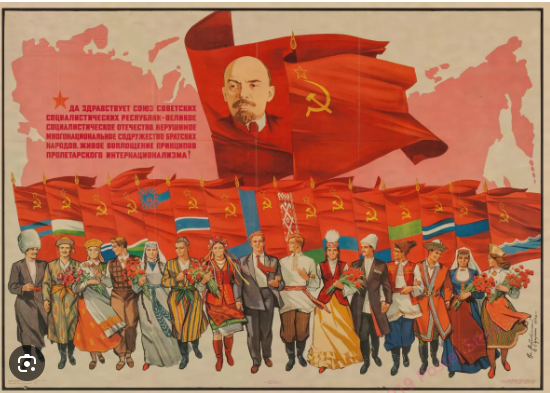
The caption of this undated Soviet poster says: "Long live the Union of Soviet Socialist Republics - great socialist Fatherland, the indestructible multinational community of fraternal peoples is the living embodiment of the principles of proletarian internationalism."
The Soviet Union (historical Russia) collapsed, among other things, because of the “atomic bomb” laid by Lenin, the status of the republics of the USSR. Nevertheless, the rapid growth of nationalism in the late 1980s was the result of the ideological collapse of the Soviet regime and the sharp weakening of the system of state power, and not the root cause of this weakening.
In the Soviet Baltic States, for example, the extreme nationalist forces were not active until a certain point – until they realized that Moscow would not – was not capable or intending – to punish outright separatism. And this is despite the fact that the CIA had been pumping agents and money into the Baltic States for decades, including active engagement in psychological operations.
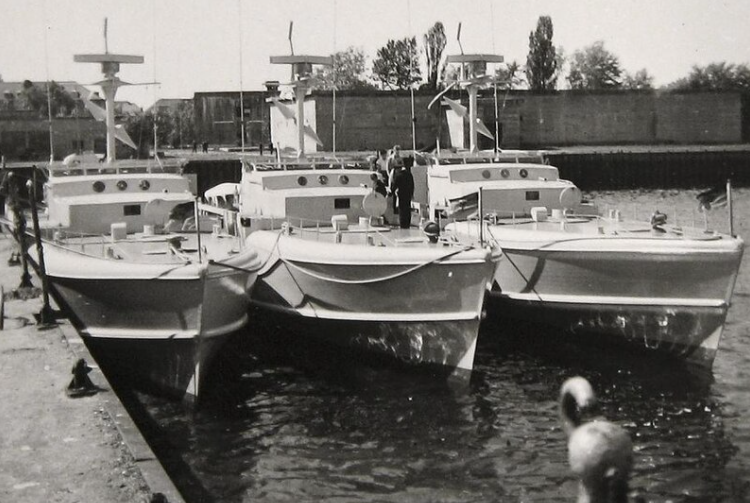
From 1949 to 1955 the British MI6 Operation Jungle attempted to land agents in Poland and the Baltic states by fast boats like these.
Now the Kiev regime and its special services are publicly boasting about operations of this kind against Russia — and a British newspaper is relishing these details.
 From the point of view of Russian legislation, we are faced with subversive, anti-state activities which can be characterized as terrorism, incitement to overthrow state power, and incitement to ethnic hatred. Consequently, the relevant Ukrainian structures should also be characterized by us as terrorists and their leaders as leaders of terrorist organizations. Also, the newspapers which give them a platform are like propagandists of terror.
From the point of view of Russian legislation, we are faced with subversive, anti-state activities which can be characterized as terrorism, incitement to overthrow state power, and incitement to ethnic hatred. Consequently, the relevant Ukrainian structures should also be characterized by us as terrorists and their leaders as leaders of terrorist organizations. Also, the newspapers which give them a platform are like propagandists of terror.


